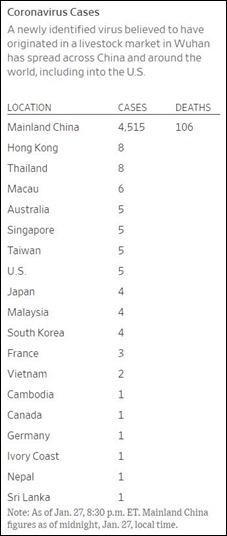The Chinese Coronavirus. What you might want to know.
Posted By RichC on January 29, 2020
Read an outstanding article in the WSJ this past week as the Novel Coronavirus (2019-nCoV) continues to spread and take lives. It is currently a China-based virus that likely stems from bats that mutate and spread through other mammals. Efforts are being made in China to prevent spreading within their country, but with travel and aviation, every country is at risk. A chart as of January 27, 2020 highlight the number of cases and deaths.
Efforts are being made in China to prevent spreading within their country, but with travel and aviation, every country is at risk. A chart as of January 27, 2020 highlight the number of cases and deaths.
Since Katelyn worked on SARS detection research when she was pre-Med with NASA Sharp as an intern in New Mexico, the quick detection and hopefully eventual vaccine are at the top of my mind.
Before we panic, let’s put this in perspective with the contagious influenza virus. The vaccine is offered every year yet people are pretty casual about getting it … EVEN though thousands in this country die every year (2017 – 2018 deaths were estimated at 61,000 according to the CDC), so let’s keep this current scary contagion in perspective.
Here are a few points:
How dangerous is the new coronavirus?
It appears to be less deadly than a related pathogen — severe acute respiratory syndrome, or SARS, which erupted in China in 2002 and spread globally in 2003. SARS killed about 10% of the people it infected, while about 3% of the people confirmed to be infected with this new coronavirus have died. Many of those who have died are elderly or have other illnesses such as diabetes. But the new virus may spread from one person to another more easily than SARS, some early disease modeling suggests.
What is a coronavirus?
This new virus belongs to a family of viruses known as coronaviruses. Named for the crown-like spikes on their surfaces, they infect mostly bats, pigs and small mammals. But they mutate easily and can jump from animals to humans, and from one human to another. In recent years, they have become a growing player in infectious-disease outbreaks world-wide.
How is the virus spread among humans?
Seven strains are known to infect humans, including this new virus, causing illnesses in the respiratory tract. Four of those strains cause common colds. Two others, by contrast, rank among the deadliest of human infections: SARS and Middle East respiratory syndrome, or MERS.
Where did this new coronavirus come from?
The new virus likely came from bats, scientists say. It isn’t known exactly where or how it jumped to humans, though. Health officials believe the outbreak originated in a large animal and seafood market in Wuhan, China. Of the first 41 cases, 27 had some exposure to that market, according to a report in the medical journal the Lancet. But three of the first four people to become ill, on Dec. 1 and Dec. 10, said they had no contact with the market. Scientists say it will take some time to identify the exact source.
How is the virus spread among humans?
It is likely spread through a cough, kiss or other contact with saliva, Chinese officials say. MERS and SARS spread mainly through “respiratory droplets” produced when someone coughs or sneezes. Those two viruses spread mostly through close contact.
How easily does the new virus spread?
See the WSJfull story in the tweet below.
An excellent Q & A article on the Coronavirus @WSJ https://t.co/GdvHkq6tne
— Rich Corbett (@RichC) January 28, 2020
Comments